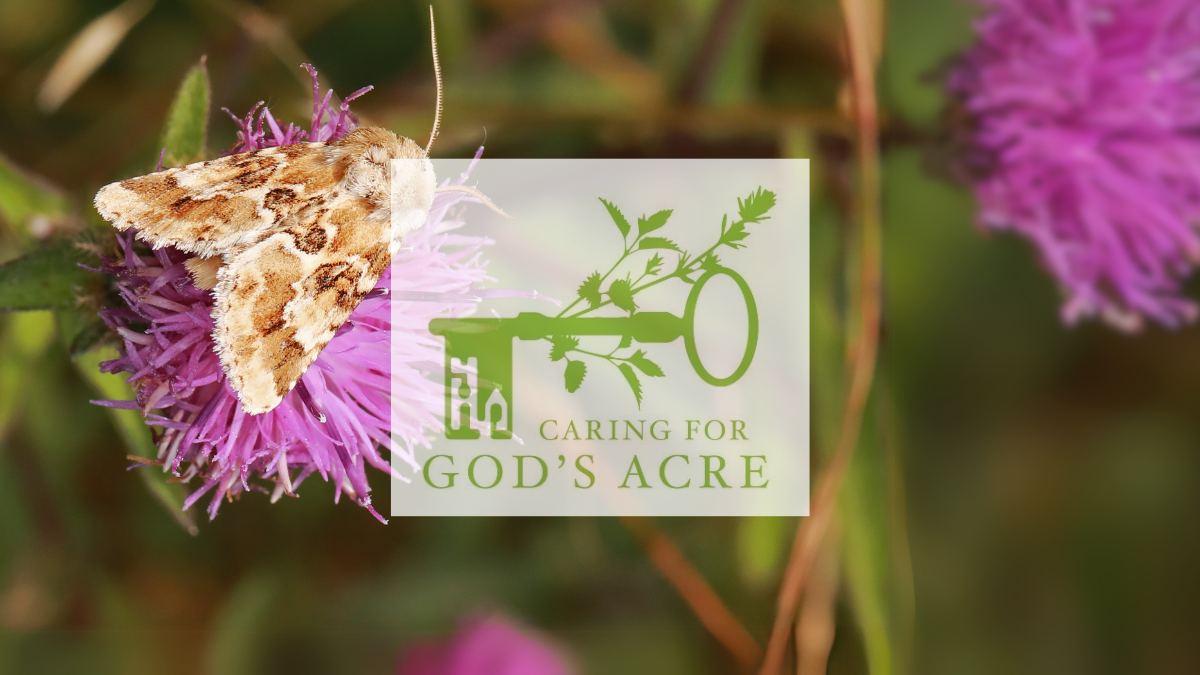
Q: Where would you find a Hebrew Character, a Camomile Shark and a Striped Wainscote?
A: In a churchyard!
In the UK we have 59 species of butterfly, many of them familiar to us all, but did you know that we also have over 2,500 species of moth? Many moths have fabulous names. Some give a clue to their markings including Hebrew Character, China Mark, Garden Tiger or Orange Underwing. Others suggest possible frustration at identifying them, Uncertain or Clouded Drab for instance! Others give a clue to the food plant of the caterpillar, Appletree Skeletoniser or Bird-Cherry Ermine. And then there are names to let your imagination fly; Hoary Footman, Snout, Dusky Brocade, Scarce Dagger and Clifden Nonpareil for starters.
Most moths have evolved to fly at night in order to avoid predation, although they are the main food of bats, who have also evolved to fly at night. To avoid bats, some moth species can hear the eco-location used by bats and will zig-zag away or drop to the ground from mid-air when bats are close, to ‘play dead’ until the threat has passed. Whilst daytime predation of night-flying moths is reduced, moths and also their caterpillars are an important food item for creatures active in the day including small mammals, amphibians, spiders, lizards and many birds. Small moth caterpillars are fed in great number to the chicks of many of our common birds including blue tit, great tit, robin, wren and blackbird.
As with so much of our wildlife, moths are in trouble, down 28% in overall numbers since 1968. This is likely to be due to a combination of factors; agricultural change, increased use of garden and farming chemicals, development and also light pollution which has a profound effect on the lifecycle of moths. Churchyards, chapel yards and cemeteries can be a moth haven however. Many contain a mix of grassland, mature trees, scrub and flowerbeds, lots of different habitats, used by a wide range of moth species. Churchyards and other burial grounds are usually free of herbicides and pesticides which benefits all insects, including moths.
There are also small management changes that will encourage and support moths; similar to gardening for wildlife, be a little untidy! How about leaving areas with leaf litter, dead plant stems and tussocks for overwintering caterpillars and eggs. If you have flowerbeds or planters, how about introducing some night-scented flowers including honey suckle, tobacco plant, evening primrose and stocks. Is there an area of turf that can be allowed to grow long for 3 to 4 spring and summer months, providing meadow flowers and flowering native grasses for pollinators including moths? A particularly helpful change might be to reduce light pollution by keeping any outdoor lights low, pointing downwards and not on all night long.
Running a moth light trap overnight makes an interesting public event, the trap is opened in the morning, moths admired, identified and then released, but even if you do not manage to see these spectacular nighttime visitors, remember that our blue tit population need an estimated 35 million moth caterpillars every year and many people enjoy watching bluetits!
N.B If you are starting to identify moths, take a look at Moths Flying Tonight on the Butterfly Conservation website and put in your postcode to narrow down the moths you are likely to find.
All the best,
Harriet Carty
Diocesan Churchyard Environmental Advisor
www.caringforgodsacre.org.uk - individuals and groups in the diocese receive 20% members discount on all CfGA materials. Use the discount code diomem22
